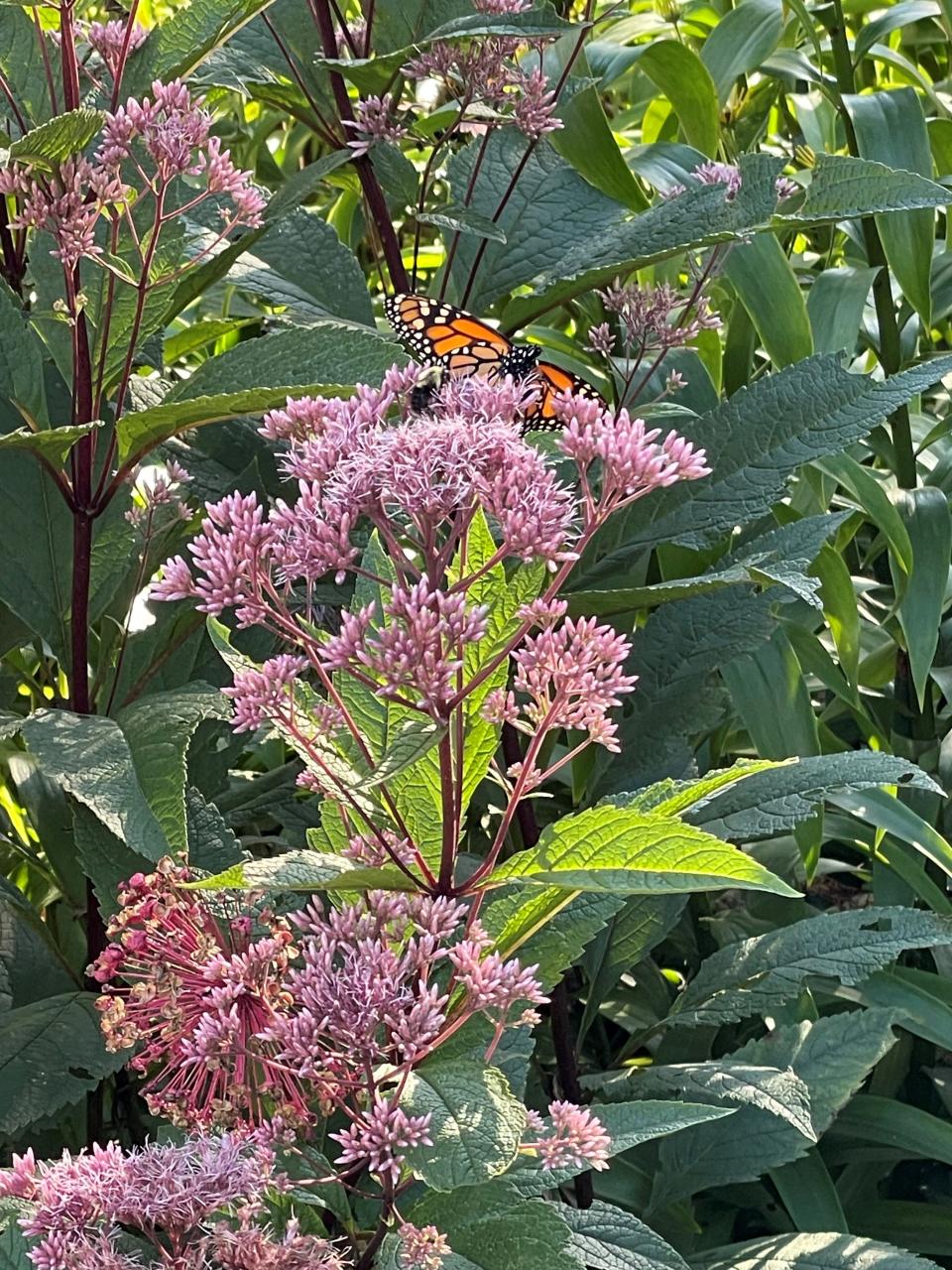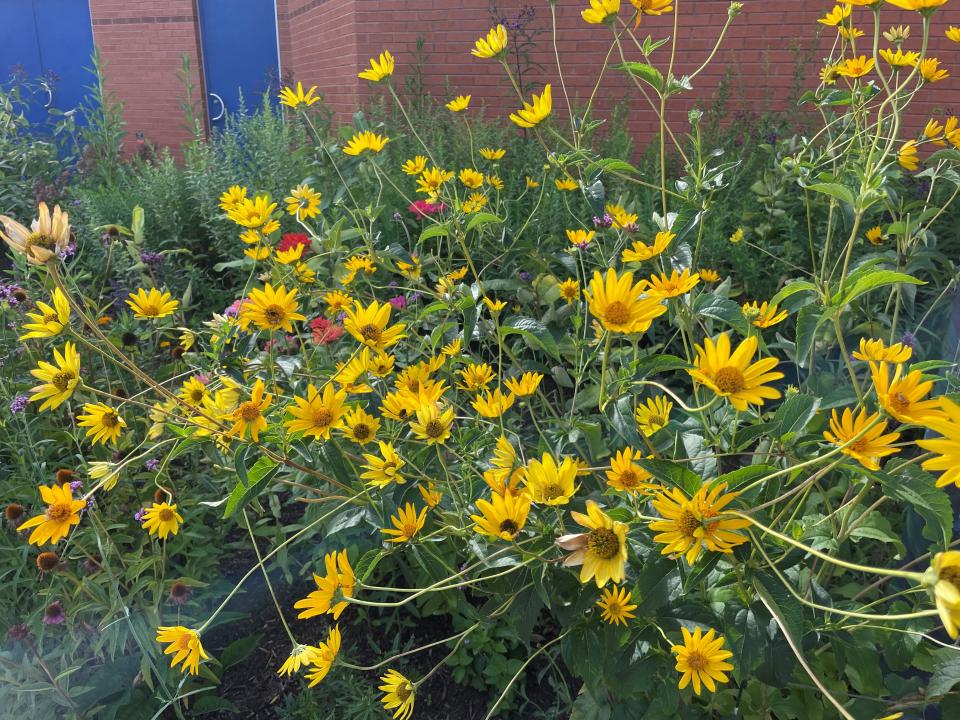These NJ native plants support monarch butterfly migration | Gardener State
On their journey from Canada to Mexico, migratory monarch butterflies stop in New Jersey from September through November to rest and wait for favorable weather to continue their migration across the Delaware Bay.
By the time they arrive in New Jersey, the butterflies are tired, with thin, tattered wings from traveling up to 100 miles per day. Luckily, New Jersey has a number of native plants that attract, feed, and provide habitat for these butterflies.
Common Milkweed (Asclepias syriaca) is a required host for monarch caterpillars in the beginning stages of life. It grows up to 5 feet tall, and blooms white and purple from June through August. It grows well in sunny environments with moist soil and is not preferred by deer when foraging. While this plant is essential to the survival of caterpillars, the migrating butterflies need other plants to make their way to Mexico.
New England Aster (Aster novae-angliae) is a flowering plant which can grow from 3-6 feet tall and provides an important food source for migrating monarchs. It thrives in medium to moist soil, and full to partial sun. It blooms in August through October, sporting lavender and pink flowers, which also attract many birds, bees, and other pollinators. New England Asters are also deer resistant!
More: Everything to know about New Jersey native trees | Gardener State
Blue Mistflower (Conoclinium coelestinum) is another native plant which grows up to 3 feet in height, and thrives in moist, loamy soil under full sun to partial shade. Blue Mistflower blooms in shades of blue and purple from July through November, which allows plenty of time for monarchs to visit the flowers. Many bees and other butterflies also benefit from this plant, while deer usually do not bother it.
Blazing Star (Liatris spicata) is a tall, thin, perennial which grows from 2-6 feet in height. It has slender, grass-like leaves surrounding the base of the plant, and a taller stem to support the flower cluster at the top. This deer tolerant plant grows best in moist, sunny conditions, and flowers in a tall spike of purple and white flower clusters from July to November. Monarchs are likely to be found on Blazing Star, as are several species of birds, bees, and other pollinators.
Joe Pye Weed (Eutrochium purpureum) is an herbaceous perennial that thrives in medium moisture soils and full sun to partial shade. This plant grows from 5-7 feet in height and forms clumps when established. It blooms from July to September with small, vanilla-scented, mauve pink flowers on top of long stems, which then form attractive seed heads during the winter. Joe Pye Weed is deer tolerant and attracts butterflies while it is in bloom. Later in the fall, the seeds provide an important food source for local birds.

False Sunflower (Heliopsis helianthoides) is an herbaceous perennial that grows to about 5 feet in height. It thrives in dry, sandy soils, and needs partial to full sun. This plant blooms from June through September with yellow flowers that look like miniature sunflowers. Another great monarch plant, the false sunflower is known for being cold tolerant, as well as rabbit and deer tolerant.
More: Got a small space? What to know about container gardening | Gardener State
Goldenrod (Solidago canadensis) is a fast-growing perennial that is native to New Jersey. It grows up to 7 feet tall and thrives in moist soils and full sun to partial shade. Its drought and salt tolerant coastal relative, Seaside Goldenrod (Solidago sempervirens) can also be found growing in sand dunes and coastal environments. Both species have yellow flower panicles that are located at the end of each stem, and bloom from July to October. These goldenrods provide habitat, pollen, and nectar for monarchs and other pollinators well into the fall.

These plants (and more) can be added to any garden or landscape to help support the migration of the monarch butterflies across the country! Native plants are also important for the New Jersey ecosystem as well as other pollinators, birds, mammals, and insects that live in our state.
In addition to New Jersey’s native ecosystems, many gardeners, birders, and even golfers, have dedicated time to helping monarchs.
More than 20 golf courses throughout New Jersey have dedicated land to growing monarch-friendly plants and almost one thousand gardens in New Jersey have been registered as Monarch Waystations by Monarch Watch, an organization dedicated to tracking and protecting monarch populations. One local Monarch Waystation is maintained by the Rutgers Master Gardeners of Monmouth County at the Monmouth County Agricultural Building in Freehold.
To do your part to help the monarchs, you can start a waystation of your own by adding plants such as milkweed and other natives to a garden or natural habitat, and registering it at monarchwatch.org/waystations/#register.
William Errickson is the Agriculture and Natural Resources Agent for Rutgers Cooperative Extension of Monmouth County. Erin Quinn is an intern for Rutgers Cooperative Extension of Monmouth County.
This article originally appeared on MyCentralJersey.com: Monarch butterfly migration supported by NJ native plants

